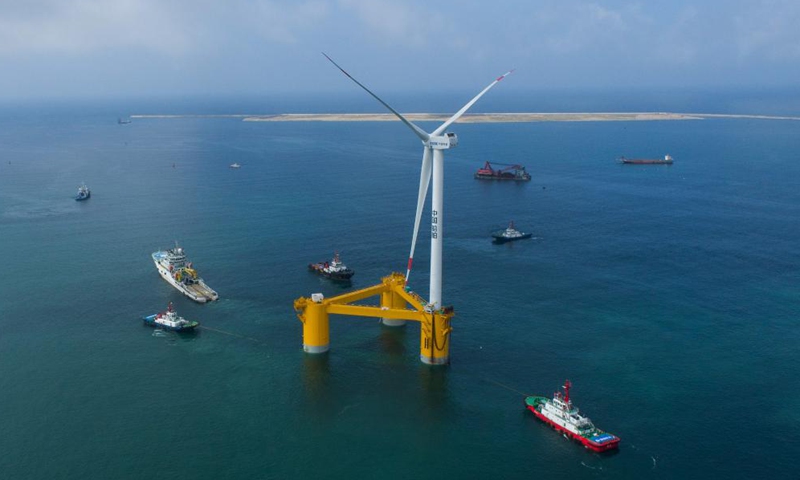
Aerial photo taken on May 27, 2022 shows a deep-sea floating wind power equipment "Fuyao" in Maoming, south China's Guangdong Province.Photo:Xinhua
China, as the world’s largest developing country, has made great achievements in carbon reduction during the past decade, cutting its carbon emissions per unit of GDP by half from 2005 levels.
Despite intensifying challenges ahead, the direction of reducing carbon emissions will not be changed and China retains huge potential in developing new energy resources, experts said on Saturday.
In 2021, the national carbon dioxide emissions per unit of GDP fell by 3.8 percent year-on-year, approximately 50.3 percent lower than 2005 levels. The total energy consumption sourced from coal dropped from 72.4 percent in 2005 to 56 percent in 2021, according to Zhao Yingming, vice minister of the Ministry of Ecology and Environment.
Non-fossil fuel energy now stands at 16.6 percent of the country’s total energy consumption in 2021, Zhao said.
The installed capacity of renewable energy reached 1.06 billion kilowatts, accounting for 44.8 percent of the country’s total energy output. Among the renewable energy, the installed capacity of wind power and photovoltaic power both exceeded 300 million kilowatt-hours, ranking the first globally.
As a result, the amount of harmful particulates in the air in China fell 40 percent from 2013 to 2020, Bloomberg reported, citing a research by the University of Chicago’s Energy Policy Institute.
The improvement of air quality in China’s large cities has been notable. In 2021, the number of blue-sky days in Beijing came in at 288 days, or 78.9 percent of the calendar year, up by112 days from 2013.
As the world’s largest developing country, China has realized a rapid drop in carbon intensity – carbon dioxide emissions per unit of GDP – over recent years, and has fulfilled its commitment to the international community, Ma Jun, director of the Beijing-based Institute of Public and Environmental Affairs, told the Global Times on Saturday.
China has vowed to reach peak carbon dioxide emissions by 2030 and achieve carbon neutrality by 2060, referred to as the country’s “dual carbon” goals. “Carbon intensity will continue to decrease in the coming months and years,” Ma said.
In the meantime, realizing the “dual carbon” goal will not be simple and easy, especially when the world is facing multiple challenges, including the COVID-19 pandemic, the Russia-Ukraine conflict and the intensifying energy supply crisis, according to Ma.
In recent years, many countries in the world have stepped up efforts to ensure energy security, including China. Energy is the foundation of economic and social development. Fulfilling the premise of ensuring safe, clean and efficient utilization, China moved to release high-quality coal production capacity.
Despite the adjustment, the trend of overall carbon reduction will not change, Ma said, noting that China retains a huge potential when it comes to developing new energy resources.
The exploitable capacity of hydropower technology in China is estimated to be 687 million kilowatt-hours, of which only 57.1 percent is developed.
Chinese governments at various levels have been implementing measures to boost new energy development, and many businesses have also been eyeing the lucrative new energy business.
For an example, The government of the Hong Kong Special Administrative Region (HKSAR) has stated its intention to invest an additional HK$240 billion to tackle climate change over the next 15 to 20 years, which will create opportunities for a green economy in many sectors, Christopher Hui Ching-yu, the Secretary for Financial Services and the Treasury of HKSAR, said Friday.
Ma added that besides increasing investments in new energy resources, it is also important to improve energy efficiency, especially relating to the industrial sector, and to shore up the storage technology for new energy and enhance the construction of a nationwide intelligent grid.
Global Times




